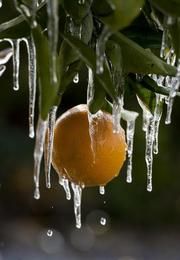With our first serious cold snap of the season approaching, you may be wondering how you can protect your Tampa landscape from freeze and frost damage. While it is unlikely that your tender and delicate plants will emerge unscathed, there are some things that you can do to minimize the damage. Before we explore ways to protect your Tampa landscape, let's discuss the potential damage to plants from either freeze or frost.
Frost is a common weather event in a typical winter in Tampa, and usually will occur several times in the months of January and February. While we may occasionally have a mild winter without frost, it should be considered a rarity. As a general rule, frost will not settle under the canopy of a large shade tree, in most areas around a structure such as a house, or on windy nights. One easy way for you to determine the frost prone areas of your landscape is to observe where the frost is, when we do have frost. Once you have observed the "frost zone", it will give you a better idea of what areas need to be addressed for protection. As well, this information may come in handy in the future, should you decide to re-landscape some areas with cold hardy plants.
Frost damages cold-sensitive plants by settling on their leaves, new growth, and flowers, while plants that are cold hardy will not be affected. Frost will generally not kill a plant, although it may cause leaf drop and die back that can take months or even years to recover from. I find that plants like Hibiscus will rebound quickly from frost damage, whereas plants like Croton can take several months or even years.
Freeze is an uncommon weather event in Tampa, but it does occur often enough to warrant attention. While we may occasionally experience temperatures at 32 degrees, it is temperatures at or below 32 degrees for more than 4 hours that should be of concern. With extended hours of freeze, all cold-sensitive plants can be affected, including those that are generally not affected by frost (your frost-free zones). If an area of your landscape is capable of reaching temperatures at or below freezing for more than 4 hours, it is possible that your cold-sensitive plants will be affected. Freeze can kill plants at their leaf, stem, and root, and can be quite devastating to a landscape that is not cold hardy.
With the above in mind, here are some tips to protect your Tampa landscape from freeze and frost damage:
- Determine if you should be protecting your plants from freeze, frost, or both
- Identify the frost prone areas in your landscape; then identify which plants may need to be protected that are in the frost zone
- For frost protection, cover the plants with burlap, quilts, or commercial frost cloth, or create a tent-like canopy with thin material such as tarps or sheets. Denser cloth like burlap can rest on the plant leaf as frost most likely will not penetrate; thinner material like sheets will need to be "tented" over the plant, as frost will likely penetrate the fabric. If necessary, anchor the material with clothes-line pins, or large book binder clips (to prevent covering from blowing off plants)
- Turn off your sprinklers. If plants are dry a few days prior to a potential frost or freeze, it is advisable to irrigate them, so that they are less stressed. However, irrigating plants during a frost or freeze may actually damage the plants more by blanketing them with ice. While that is appropriate for commercial fruit and produce growers, it is not for a landscape.
- If a severe freeze is predicted (below 32 degrees for more than 4 hours), the trunks of valuable plants, trees, and palms should be wrapped in blankets, as well as the canopy, to prevent trunk splitting. Oak leaves, hay, mulch, or pine needles can be piled at the root system to prevent root kill.
- Do not cut back or trim any damaged plants until spring. The frost or freeze damaged plant material serves as a buffer for any future damage. As well, trimming often promotes fresh growth that will be prone to additional frost or freeze die-back.
- Do not leave protected coverings on for an extended period of time. Quite often, after a frost or freeze event, our Tampa temperatures will climb to make for another hot and sunny day, and the covered plants can actually suffer from heat burn.
- Throughout the rest of the winter season, continue to maintain your plants as normal, even if they look dead. While you should not trim or fertilize, you should not let them dry out, so irrigate as needed. Even if your plant looks dead, it probably isn't and you will be rewarded in the spring for your patience.
While this current frost and freeze forecast seems ominous, I would suggest that it may not be as bad at it seems. Frost is predicted, but heavy winds should prevent it from settling, thereby minimizing damage. As well, while freeze is a possibility in some areas, it is not likely to be for 4 hours or more. Of course, weather predictions are just that, and not a certainty, so it is always best to be prepared.

